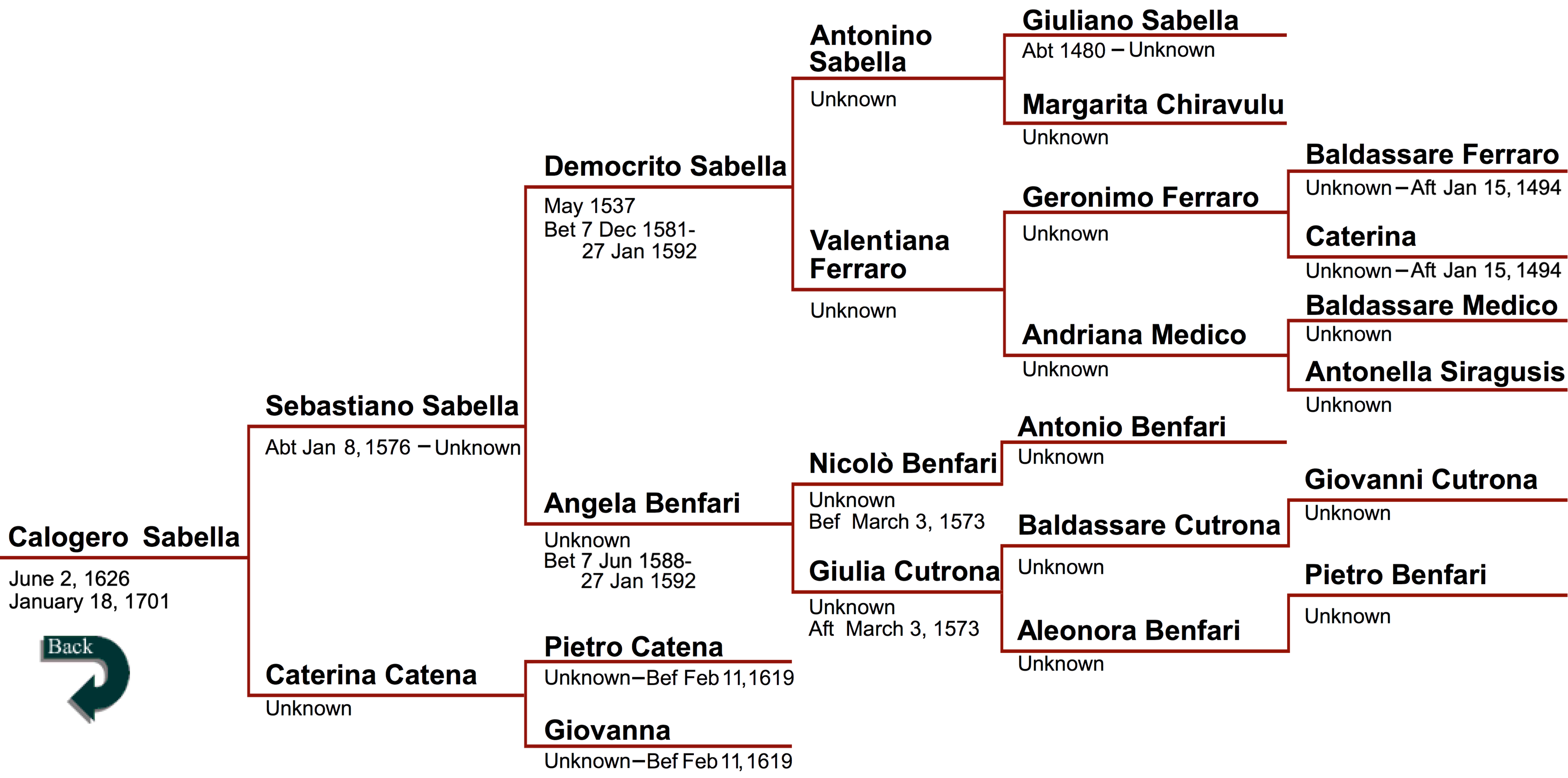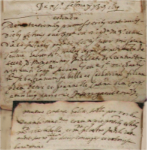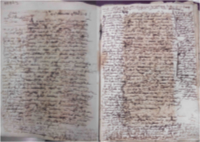Calogero Sabella's Ancestors |
Click on a name to read more about the person, click on an arrow to follow that branch. Click Home to go to the main page or click for an Alphabetic List of Names. |
 |
Translations provided by members of the GenAG - Genealogie Agrigentine and the Italian Genealogical Records Facebook groups. Note that the Latin months September thru December are often written in numbers, 7ber, 8ber, 9ber and 10ber, respectively. ~<^>~ |
| ~<^>~ |
In Sciacca in about 1594, Sebastiano married first a woman named Leonarda, surname unknown. They had at least eleven children all baptized at the St. Michele church in Sciacca on the dates shown — Filippa Dorothea on October 4, 1595; Antonino Francesco on October 21, 1596; Vincenzo Antonino on October 15, 1598; Angelica Calogera on January 8, 1600; Angelica Virginea on December 3, 1602; Michael Vito on February 28, 1604; Angela Domenica on August 3, 1605; Maria Juilia on January 8, 1608; Giovanni, just 11 months later on November 5, 1608; Michele on March 17, 1610, who died at 6 months old on October 4, 1610; and another Michele on September 11, 1611, who married Antonella Mancuso at the St. Vito church in Sciacca on October 29, 1628. Sebastiano’s wife Leonarda died on December 27, 1618, and was buried at the St. Michele church. Less than 2 months later Sebastiano remarried.  On February 11, 1619, at St. Michele’s church in Sciacca, he married Caterina Catena, the daughter of Pietro Catena and his wife Giovanna, whose surname is unknown. (Mouse over and click on their church marriage record image left to enlarge it in a new window or tab.) Sebastiano and Caterina had at least five more children, all baptized at the St. Michele church in Sciacca on the dates shown — Thomas Joseph on December 22, 1619; Vito Gaspare on June 3, 1626; ancestor Calogero; Pietro Joannes on June 25, 1629, who was probably named after his mother’s father; and Michele, who was baptized as Michael Isadori Petrius on September 29, 1634. All that is known about Caterina’s parents is that her father and mother were deceased on the day she was married. It is not known when Sebastiano and Caterina died. Unfortunately, nothing else is known about Sebastiano, Caterina and her parents Pietro and Giovanni. |
| ~<^>~ |
Democrito Sabella was baptized in Sciacca, Agrigento, Sicilia, Italy, in May of 1537, the son of Valentiana Ferraro and her husband Antonino Sabella. Besides ancestor Sebastiano, Democrito and Angela had at least three other children born in Sciacca. The first two were baptized at the mother church there and the last one at St. Vito’s, as follows — Tommaso Vincenzo, who was baptized as Masi Vinco Mazio on September 5, 1579; daughter Filippa Giacoma who was baptized as Pha Jaca, on December 7, 1581, but listed on the index as Pha Jacoba; and Antonino Thomas on June 7, 1588. They may have had other children, but these are the only ones with baptism records found so far. Angela probably was the only mother known to Nunzia’s last three children. Democrito was called a Magnifico, like his father. This title translates to magnificent. They “were called the jurors of the time who were the administrators of the city (mayor, councilors of today). Today the title in Italy is held by the dean or rector of universities.” It is not known when Democrito and Angela died, but they both were alive when their last child was born in 1588 and deceased by the time their son Antoni was married on January 27, 1592. So they both died sometime within that four year span, but death records are not available to confirm this. Unfortunately, nothing else is known about Democrito and Angela. |
| ~< Back to Chart >~ |
Five mother church baptism records have been found that are most likely the children of Antonino and Valentiana. There are no detail register records before September of 1543, so the first four are index records only. These index records only list the father’s name and month and year of the baptism. The fifth child has an incomplete detail record with an incorrect surname on the index record. The given names of these children all seem to be in line with ancestor Democrito’s name. They are as follows — Marta Antonia Agrippa in August of 1535; ancestor Democrito; Pamfilia Margarita, was given the middle name of her paternal grandmother in December of 1542; Giulia Caterina, who was named the female version of her paternal grandfather’s name in January of 1543; and Gioanella Angeletta on April 14, 1544. Unfortunately, nothing else is known about Antonino and Valentiana. |
| ~<^>~ |
Seven Sciacca mother church baptism records have been found for the children of Cola Benfari. The full register records begin in September of 1543, but the index begins in 1528. The available register baptism records for these children are extremely hard to read. Although the indices are clearer, they only list the month and year of the baptism. They all state the father’s name as Cola, which is what he is called on ancestor Angela’s marriage document. The mother’s name is not mentioned in either the indices or the register records. The baptism info for these seven children is as follows —Mirolea in September of 1530; Margarita in March of 1539; Antonino Joseph Giuseppe in March of 1542; Nicolia in February of 1544; Vita Carmilla in August of 1545; Spuria Benvenuta Novella in August of 1546; and Sebastiano Antonio on January 12, 1548. A baptism record for Angela’s name has not been found. It is possible that she is one of the daughters mentioned above, but using the name Angela. Nothing is known about Nicolò’s father, only his name Antonio, is mentioned in Nicolò’s marriage contract. It is also not known when Nicolò and Giulia died, but he was deceased and she was still alive when their daughter ancestor Angela was married on March 3, 1573. For now nothing else is known about them. |
| ~<^>~ |
Giuliano Sabella and Margarita Chiravulu’s ancestries are unknown, but they lived in Sciacca, Agrigento, Sicilia, Italy. It is estimated that Giuliano was born around 1480. What we know of them comes from their marriage, which is documented in the book, Andrea Randazzo un notaio storico Volume Primo. The author Pellegrino Mortillaro, organized the data, including marriages, from the beginning of the 15th century to the 1700’s that was compiled by the notary Andrea Randazzo, who lived in Sciacca between 1726 and 1756. Mortillaro translated the Latin records into Italian, preserving the data and making it easier to research. It doesn’t give details of the events, just the basic information, but it is a wonderful tool for researchers. 
Giuliano and Margarita were married on October 12, 1509, in Sciacca. (Mouse over and click on their marriage contract listing image left to enlarge it in a new window or tab.) The pictured image is from a dowry deed written by notary Vincenzo Perniciaro, and “is taken from a manuscript containing the indices of the dowries and testaments of the notaries of Sciacca from about 1434 to 1680.” It should be noted that in both documents Giuliano’s surname is spelled Isabella. Their only known child was ancestor Antonino. Unfortunately, nothing else is known about them, so our Sabella line ends with them. |
| ~< Back to Chart >~ |
Geronimo Ferraro is the only known son of Caterina and Baldassare Ferraro. Although his given name was said to be as Girolamo, it is recorded as Geronimo in several places in both volumes of Pellegrino Mortillaro’s book, Andrea Randazzo un notaio storico. There are no records that call him Girolamo. It turns out that Geronimo is the Italian form of the Latin name Hieronymus, meaning holy name, which is of Greek origin. Gerolamo is the Italian form of the Latin name Hieronymus, meaning holy name and Girolamo is a variant spelling of the Italian name Gerolamo, again meaning holy name. So today he would be called Girolamo.
Volume 1 of Mortillaro’s book, states that on November 26, 1511, an “agreement between Geronimo Ferraro, and Antonino Medico” was made. This is six years after he married into the Medico family, so this is probably our ancestor. Antonino may be his wife’s brother. Four years later on October 7, 1515, there is an entry which roughly translates to “Return of the dowries from Geronimo to Andreana Ferrario.” Also of interest is a statement for the sale of the Territ. by Carbollaci, where a Gio. Filippo Ferraro is made one of the heirs of Geronimo Ferraro. There are also two inventory entries for the name of Geronimo Ferraro, one dated July 31, 1534, and the other November 27, 1592. It is unknown if these last three statements are for our ancestor or even if they are for the same person. Unfortunately, this is all that’s known about Geronimo, and his wife Andriana. |
| ~<^>~ |
Little is known about Baldassare and Aleonora, but their fathers were both Sciacca notaries. Giovanni served as a notary in Sciacca from 1489 to 1534 and Pietro served in 1482, 1483 and again from 1492 to 1497. Being that Giovanni served for 43 years, it is likely he died soon after he retired. It is not known when Baldassare and Aleonora died, but there is a marriage contract dated May 4, 1525, for an Aleonora Benfari and Pietro Falco that was issued by notary Giovanni Cutrona. Being that 14 years past since Aleonora married Baldassare, it could be that he died and she remarried or it could be just a coincidence! Unfortunately, nothing else is known about them. |
| ~< Back to Chart >~ |
Caterina and Baldassare had at least two children who both married in Sciacca — ancestor Geronimo; and his sister Nicolosa, who entered into a marriage contract with Antonio Panormo on January 3, 1497, which is documented in volume 1 of Pellegrino Mortillaro’s book. Caterina and Baldassare probably had other children, but no records of them have been found. It is not known when Caterina and Baldassare died, but the fact that Caterina was alive when she wrote her will and she is listed as the wife, not the widow of Baldassare, they both died sometime after January 15, 1494. This is all we know about them, so our Ferraro line ends with them. |
| ~<^>~ |
Baldassare Medico and Antonella Siragusis’ ancestries are unknown. What we know of them comes from the first volume of Pellegrino Mortillaro’s book, Andrea Randazzo un notaio storico. Baldassare and Antonella lived in Sciacca, Agrigento, Sicilia, Italy, and they are the documented parents of ancestor Andriana and two other children. Their children’s birthdates are not known, but they both entered into Sciacca notarial marriage contracts as follows — daughter Autilla married twice, the first contract was to marry Giovanni Antonio Panormo on March 21, 1501, and after he died she was contracted to marry Raimundo Peralta on January 5, 1507; ancestor Andriana was contracted to marry next; and lastly, son Filippo was contracted to marry Giulia Maringo on November 20, 1506. Baldassare and Antonella probably had other children, but no documentation has been found for them. This is all we know about them, so our Medico line ends with them. |
| ~< Back to Chart >~ |

 The actual baptism date is unknown as the only record is an index of it. His given name is spelled several different ways, as on the Latin baptism index (pictured left) it is spelled Demortra. Some of the records spell his surname differently, as in his first marriage, which is recorded as “Democrito Isabella, son of Antonio, and Valentiana Isabella Ferrario,” married first Nunzia Perollo on August 17, 1559, in Sciacca. They had at least five daughters and one son together,
The actual baptism date is unknown as the only record is an index of it. His given name is spelled several different ways, as on the Latin baptism index (pictured left) it is spelled Demortra. Some of the records spell his surname differently, as in his first marriage, which is recorded as “Democrito Isabella, son of Antonio, and Valentiana Isabella Ferrario,” married first Nunzia Perollo on August 17, 1559, in Sciacca. They had at least five daughters and one son together, 





